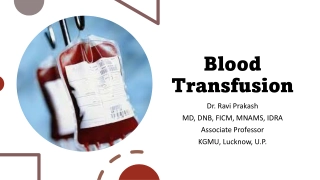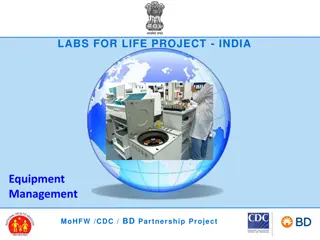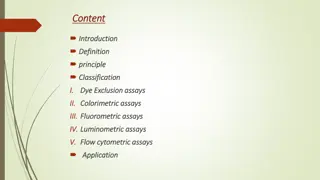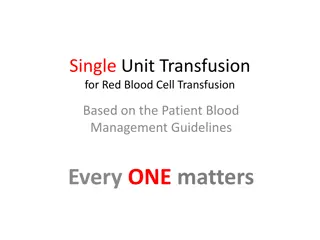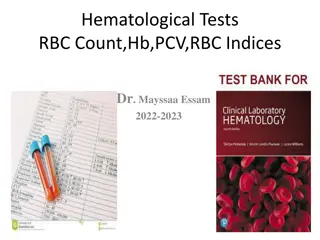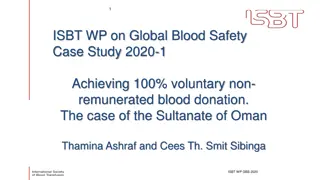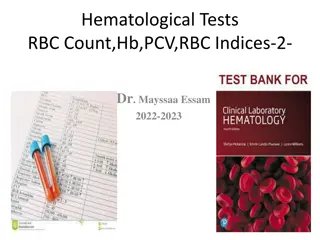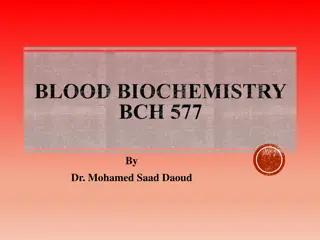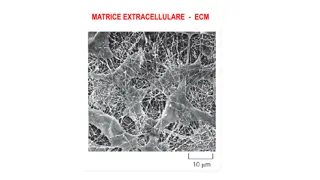Differential white blood cell count
Differential white blood cell count, also known as a leukocyte count, is a crucial test to determine the different types of white blood cells present in the blood. The cells are classified into granulocytes (neutrophils, eosinophils, basophils) and agranulocytes (lymphocytes, monocytes). Blood smear preparation is essential for accurate interpretation, involving specific steps such as placing a drop of blood on a slide, spreading it at a 45-degree angle, and fixing the film before staining. This guide provides insights into the procedure and importance of these tests in hematology laboratories.
Download Presentation

Please find below an Image/Link to download the presentation.
The content on the website is provided AS IS for your information and personal use only. It may not be sold, licensed, or shared on other websites without obtaining consent from the author. Download presentation by click this link. If you encounter any issues during the download, it is possible that the publisher has removed the file from their server.
E N D
Presentation Transcript
The white blood cells may be classified into Granulocyte: cells having granules in their cytoplasm. 1. Neutrophils 2. Eosinophils 3. Basophils A granulocyte: cells in which granules are absent. 1. Lymphocytes 2. Monocytes
Differential white blood cell count (Differential leukocyte count) determines the number of each type of white blood cell, present in the blood. It can expressed as a percentage (relative numbers of each type of WBC in relationship to the total WBC).
Blood smear blood smear is one of the most frequently requested tests in the hematology laboratory. Blood smear must be prepared correctly and examined in such a way as to provide the physician with an accurate interpretation.
Procedure 1. Place a drop of blood from the finger about 2 mm in diameter in the central line of a slide about 1-2 cm from one end. 2.The spreader is placed at angle of 45 degrees to the slide and then moved back to make contact with the drop.
3. The drop should spread out quickly along the line of contact of the spreader with the slide. 4. The drop should be of such size that the film is 3-4 cm in length.
5. The film should be dried rapidly. A good blood film preparation will be thick at the drop end and thin film at the opposite end. 6. The thickness of the spread when pulling the smear is determined by the: a) Angle of the spreader slide. b) Size of the blood drop. c) Speed of spreading.
Fixing of blood films Before staining, the blood films need to be fixed with acetone free methyl alcohol for 0.5 to 2 minutes in order to prevent hemolysis when they come in contact with water when water has to be added subsequently. Alcohol denature the proteins and hardness the cell contents.
Stain preparation and staining A. Leishmans stain Composition Powdered Leishmans stain 0.15 mg Methyl alcohol 133 ml Method of staining 1. Pour few drops (about 8) on the slide, Wait for two minutes. 2. Add double the amount (16 drops) of buffered water. Mix by rocking and wait for 7-10 minutes. 3. The stain is flooded off with distilled water and this should be complete in 2-3 second, and allow it to dry.
B. Giemsa stain Giemsa powder 0.3 mg Glycerin 25 ml Methyl alcohol 25ml This makes stock solution and before use it has to be diluted by adding 1 ml (stain) to 9 ml buffered water. Method of staining 1. The blood is fixed with methyl alcohol for 2 minutes. 2. Pour Giemsa stain diluted 1:9 with buffer over the smear for 8-10 minutes. 3. Wash off with buffer and dry.
Examination of a blood film There are several necessary step in the examination of a peripheral blood smear: 1. Under the low- power (10X), determine the overall staining quality of the blood smear. 2. Determine if there is a good distribution of cells on the smear. 3. Find an optimal area for the detailed examination and enumeration of cells.
The count The dry and stained film is examined without a coverslip under oil immersion objective. For differential leucocyte counts choose an area where the morphology of the cells is clearly visible. Do differential count by moving the slide in area including the central and peripheral of the smear. A total of 100 cells should be counted in which every white cell seen must be recorded in a table under the following heading: Neutrophil, Basophil, Eosinophil, Monocyte and Lymphocyte. Then find the percentage of each type.
Normal Results Neutrophils: 40% to 60% Lymphocytes: 20% to 40% Monocyte: 2% to 8% Eosinophils: 1% to 4% Basophils: 0.5 to 1% Band (young neutrophil): 0% to 3%
What abnormal results Mean Any infection or acute stress increases your number of white blood cells. High white blood cell counts may be due to inflammation, an immune response, or blood diseases such as leukemia. It is important to realize that an abnormal increase in one type of white blood cell can cause a decrease in the percentage of other types of white blood cell.
An increase percentage of neutrophils may be due to: Acute infection Acute stress Gout Myelocytic leukemia Rheumatic fever Rheumatoid arthritis Thyroiditis Trauma
A decreased percentage of neutrophils may be due to: Aplastic anemia Chemotherapy Influenza Radiation therapy or exposure Viral infection Widespread Severe bacterial infection
An increase percentage of lymphocytes may be due to: Chronic bacterial infection Infection hepatitis Infection mononucleosis Lymphocytic leukemia Multiple myeloma Viral infection (such as mumps or measles)
A decreased percentage of lymphocytes may be due to: Chemotherapy HIV infection Leukemia Radiation therapy or exposure Sepsis Steroid use
An increase percentage of monocytes may be due to: Chronic inflammatory disease Leukemia Parasitic infection Tuberculosis Viral infection (for example, infectious mononucleosis, mumps, measles)
An increase percentage of eosinophils may be due to: Addison ,s disease Allergic reaction Cancer Collagen vascular disease Hypereosinophilic syndromes Parasite infection
An increase percentage of basophils may be due to: After splenectomy Allergic reaction Collagen vascular disease Myeloproliferative disease Varicella infection An decrease percentage of basophils may be due to: Acute infection Cancer Severe injury











